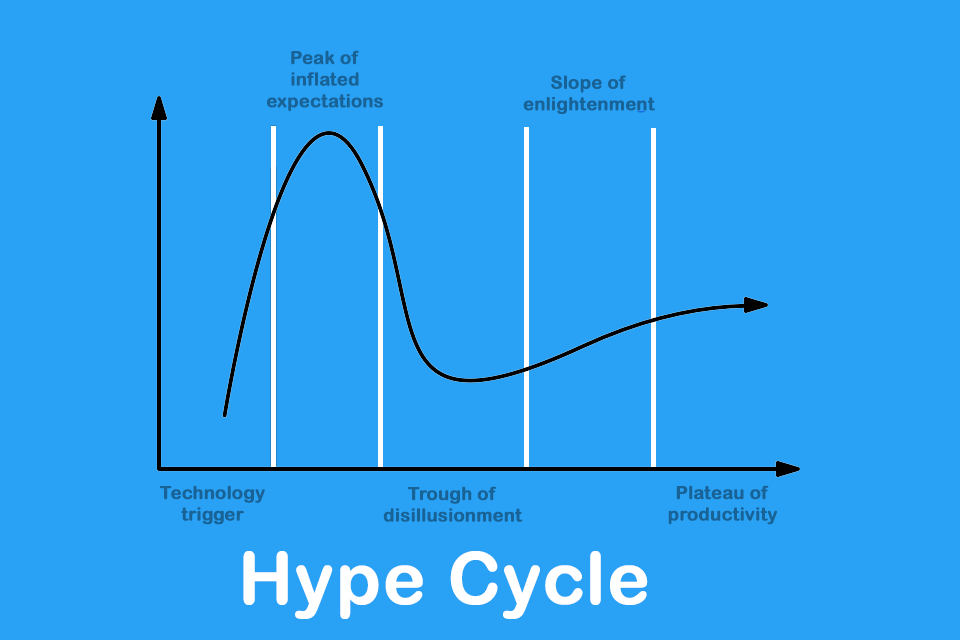What is the Hype Cycle?
Smartpedia: The Hype Cycle explains different phases of public attention that a new, hyped technology receives over time.
Hype Cycle – public attention of a hyped technology
“A hype is a particularly spectacular, rousing advertisement that causes euphoric enthusiasm for a product. It is a deception staged for the sake of public attention. Or it is a wave of superficial enthusiasm.”¹ Some products and technologies experience hype. Some ideas and business ideas too. And people get hyped too. Interestingly, this hype occurs in different phases. These phases were described by Jackie Fenn, an analyst at Gartner Inc. in 1995 in what is called the Hype Cycle.²
The Hype Cycle – alternatively referred to as the Gartner Hype Cycle – is a “graphical representation of the maturity and adoption of technologies and applications and their potential relevance to solving real business problems and exploiting new opportunities”.³ Or put another way: It depicts over time which phases a technology – in a broad sense therefore also an application, a service or a business idea – goes through from initial enthusiasm to an accepted, productively usable solution.
Phases in the Hype Cycle
The Hype Cycle has 5 phases:
- Technology trigger
- Peak of inflated expectations
- Trough of disillusionment
- Slope of enlightenment
- Plateau of productivity
The technology trigger phase usually starts with a trigger, e.g. an event that triggers remarkable interest among a professional audience. Imagine, for example, an event at which a computer manufacturer presents a smartphone on which users can install purchased apps from an app store in order to adapt the smartphone’s range of functions to their personal needs. It is the phase in which, for example, start-ups receive venture capital funding in a first round, “first generation” products are published – usually at high prices – for which numerous adjustments are still necessary. (For example, there are said to have been smartphones with which it was not particularly possible to make phone calls at the beginning of the market launch). And it is the time when early adopters deal with the products in detail.
This is followed by the peak of inflated expectations. Mass media report on the products, public attention increases and the hype begins. Alternative providers and an “early majority” of customers or users enter the market. The attention reaches its peak. It is the phase of overstatements and exaggerated expectations. The first criticism sets in, because the products do not deliver what they promise at first glance. Further development becomes more comprehensive, more complex, more expensive than expected in the first wave of euphoria. The first cracks in the hype are clearly visible.
On the way to the trough of disillusionment, there is a consolidation of suppliers and market participants disappear one by one. The reporting and enthusiasm of most market participants ebbs away. In the vast majority of cases, a comprehensive market penetration has not been achieved. It is the time when remaining players acquire second or third venture capital financing.
After the trough of disillusionment comes the slope of enlightenment. Exaggerated expectations are replaced by more realistic forecasts. Real advantages are valued by market participants and limits of the new technology are largely accepted. Mostly, the second product generation appears with improved features or services.
With the third product generation, the plateau of productivity is reached. The technology, the applications, the products or services become technically and economically more solid. A significant part of the target group has adopted the innovation. The diffusion and use of the products grows steadily, but with a flat curve.
he benefit of the Hype Cycle
Opinions vary on the usefulness of the Gartner Hype Cycle. For some, it is a tool to identify similar patterns in emerging, new technologies. As a tool, it shows which phases products or services must go through to reach the plateau of productivity. It reveals that numerous efforts must be made over time to permanently establish a new technology in the market. It is obviously often more of a marathon than a sprint. And it enables the ranking of one’s own technology in comparison to other products or services.
However, there are also perspectives that accept the descriptive benefit of ranking and visualising technologies on their way to market maturity, but do not recognise a benefit beyond that. The following criticism is voiced:
- style=”margin: 8px 0;”The Hype Cycle does not include guidance on how to initiate a hype. (Most manufacturers would be happy about a hype, but will never experience it). For example, should an attempt be made to attract a wide professional audience in parallel with the creation of a Minimum Viable Product (MVP) or the development of a prototype?
- There is no indication of how long the various phases last, nor how, for example, the trough of disillusionment can be avoided.
- Also, the difference to the visualisation of a “normal” product life cycle is not very significant. And last but not least, it is not suitable for making predictions about the success and the required market maturity of future technologies.
Impulse to discuss
Where would the Hype Cycle be classified in its own visualisation?
[1] Duden: Verschiedene Bedeutungen von Hype
[2] Jackie Fenn & Mark Raskino: Mastering the Hype Cycle: How to Choose the Right Innovation at the Right Time
[3] Gartner Hype Cycle
If you like the article or would like to discuss it, please feel free to share it in your network. And if you have any comments, please do not hesitate to send us a message.
And here you will find additional information from the t2informatik Blog:



